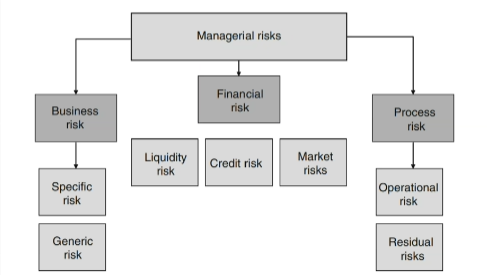Microfinance W9
1/21
Earn XP
Description and Tags
Risk Management
Name | Mastery | Learn | Test | Matching | Spaced |
|---|
No study sessions yet.
22 Terms
Risk
possibility of something bad will happen
this can be controllable or uncontrollable
things will go unplanned
any outcome that is uncertain.
Risk Management
measurement and the control of risks (expected & unexpected changes) in order to price the investment correctly and to reduce losses determined by changes in future events or outcomes
Why does risk management matter in MF?
more complex as it offers diverse products and services
need for sustainability
growing competition because some traditional banks also approach the customers like MF
ethical responsibility as they’re willing to take a risk that’s why the interest rate is high
Taxonomy of Risks

Business Risk
Specific Risk
Generic Risk
risk comes from the microfinance activity itself
example of this: nasira yung equipment, hindi nagbayad yung customer mo
Financial Risk
Liquidity Risk
Credit Risk
Market Risk
risk that comes from how you manage your money
example: don’t have enough cash
Process Risk
Operational Risk
Residual Risk
risk that comes from how you run your microfinance business
example: problem within the organizational structure or staffing
Specific Risk
product
low level of standardization in terms of
geographical context
beneficiaries
product and services
Generic Risk
environment (broader sense)
location and development policy:
financial policy
fiscal policy
regulatory policy
juridical environment
Business Risk Management
Single project - small MFIs with one branch
provisions for future losses
risk sharing
MFIs - multiple branches
provisions for future losses
portfolio diversification - lend different borrowers in different location
risk sharing
LIquidity Risk
risk of not having enough cash on hand to meet your obligation
causes:
expected changes - predictable
unexpected changes - unpredictable
Credit Risk
risk that borrowers won’t repay their loans
types:
expected loss - average amount of loss that is expected to have
unexpected loss - risk is higher than expected
Market Risk
risk that changes in the market that will negatively impact your finances
types:
interest rate risk
currency risk
Liquidity Risk Management
Single Project Approach
simpler cash flow
focus on timing
limited options
Pool of Funds Approach
more complex cash flow
balancing act
more tools
Credit Risk Management
Single Loan
Loan Portfolio
CRM - Single Loan
EL
creditworthiness analysis:
qualitative credit
scoring models
risk sharing
UL
monitoring process risk transfer
CRM - Loan Portfolio
EL
creditworthiness analysis
portfolio size
risk sharing
UL
monitoring process
portfolio size
portfolio diversification
risk transfer
Market Risk Management
Micro-Hedging - smaller projects
Macro-Hedging - larger MFIs
Operational Risks
internal factors
process
people
system
external events
legal risks
coup d’etat
others
Residual Risks
external events not included in operational risks:
catastrophic risks
terrorist risks
reputational risks
Process Risks Management
Auditing Procedures
Risk Sharing
Hedging
risk management strategy to offset losses in investments by taking an opposite position in a related asset